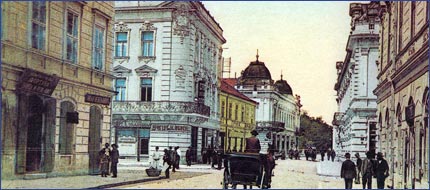
The Capital of Serbia and Yugoslavia
The intensive development of Belgrade which started after its final liberation from the Turks continued in the first years of the XX century. The construction of the railway station and river port on the Sava moved the gravitational center of the city and former Turkish-Oriental area known as Dorćol began to lose its former importance. However, the further development of the city was hindered by a fact that Belgrade was a border city and an obstacle to Austrian expansionistic policy against Balkan.
In planning of Austrian and German expansion to Balkan, an excuse was sought to attack Serbian by military force. It was found in the assassination of the Austro-Hungarian crown-prince Franz Ferdinand on June 28, 1914 in Sarajevo. World War I started with the ultimatum, and later the attack on Serbia. During four months of bombardment, the vanguards of the Austrian army entered Belgrade on December 2, 1914, but they stayed there only until December 15. The invader had to retreat due to a strengthened position of Serbia after the Battle of Kolubara. A new attack followed between October 6 and 7, 1915, led by the field marshal Mackensen. It has lasted for full 7 days and 7 nights. In spite of 9,731 wounded and dead soldiers, the Austrian army managed to enter the city. Belgrade's agony was three years long. After the breach of the Thessaloniki (former Salonika) Front the Serbian army and parts of the Allies' army liberated Belgrade on November 1, 1918. During World War I, Serbia lost 28% of its whole population, while Belgrade was the most destroyed town in Serbia.
Immediately after the liberation, Belgrade became the capital of the newly-created Kingdom of the Serbs, Croats and Slovenes, which gave it even stronger impulse for faster development. It included Zemun, which have always been in some other country before that. Thus Belgrade ceased to be a border town and began to grow fast. Along with a fast expansion towards Avala, Košutnjak, Čukarica and the Danube, numerous buildings were constructed in the old city center, which gave Belgrade the shape of a European city. However, after the assassination of King Aleksandar I Karađorđević, the political groups which showed more and more sympathies for the leaders of the new world order - Hitler and Mussolini, grew stronger. This resulted in joining the country to the Axis on March 25, 1941, but it only caused a coup d'etat, bringing the Government down and mass protests of the people.
Only a few days later, Belgrade became the target of a terrible bombing and destruction. In the attack of German air force on April 6 and 7, 1941 on this free city, 2,274 people were killed, while the number of the wounded was several times larger. Thousands of buildings were lightly or heavily damaged, and the National Library was completely burned down. It was the introduction to four years of life under occupation. The German troops entered Belgrade on April 12, 1941, facing no resistance. After all the persecutions and sufferings caused by German occupying forces, the citizens of Belgrade also had to undergo considerable losses in the Allies' bombing, especially in spring and autumn 1944. Many buildings were demolished, residential areas, as well as all the bridges on the Sava and Danube, while about 1,160 citizens lost their lives. During World War II Belgrade lost about 50,000 citizens and suffered inestimable damage and destruction. Belgrade was liberated by the units of the National Liberation Army of Yugoslavia and the Red Army on October 20, 1944.
The new communist government arrests and liquidates political opponents, mobilizes Belgrade youth and sends it to the Thessaloniki Front. In spite of enormous destruction and general poverty, Belgrade slowly began to recover from the serious consequences of the war and occupation. The destroyed economic facilities were reconstructed and new were built, especially industrial capacities (primarily in the field of metallurgy, chemical and electrical manufacturing industry), traffic and transport started to develop, cultural and educational institutions were renewed and expanded. In the political sphere, the monarchy was abolished in November 29, 1945, by the Declaration which proclaimed the Federal People's Republic of Yugoslavia a federal state with republican system of government, which was the official start of the communist rule of Josip Broz Tito. By adoption of the FNRJ Constitution on January 31, 1946, a socialist federal community of the Yugoslav peoples was established and the nationalization of the property of prewar industrialists began.
Thanks to a specific policy of Yugoslavia led by Josip Broz, Belgrade became and important international, political, cultural European, sports, and economic center. It was the place where important international meetings took place: the First Conference of the Heads and Governments of the Non-aligned Countries in 1961, then the Conference of Security and Cooperation of Europe (CSCE), the UNESCO Conference, annual meetings of the World Bank and the International Monetary Fund, the 6th UNCTAD, as well as a number of cultural, sport, and other events.
The student protests in 1968 (against intolerable social differences and arrogance of the bureaucratic apparatus) showed that there were problems at internal level. The second indicator was the national commotion in 1974. By adopting the 1974 Constitution, the state moved towards confederal system. Many unsolved national, ethnical, political, economic and other problems in the country led to disintegration of Yugoslavia in 1991, which marked the end of the longest period of peace in Balkan in the XX century. Since 1992 Belgrade has been the capital of the Federal Republic of Yugoslavia, consisting of the Republic of Serbia and the Republic of Montenegro. As of February 2003, Belgrade has been the capital of the newly formed State Union of Serbia and Montenegro. May 2006, Montenegro declares independence and Belgrade becomes the capital of the independent state of the Republic of Serbia.

